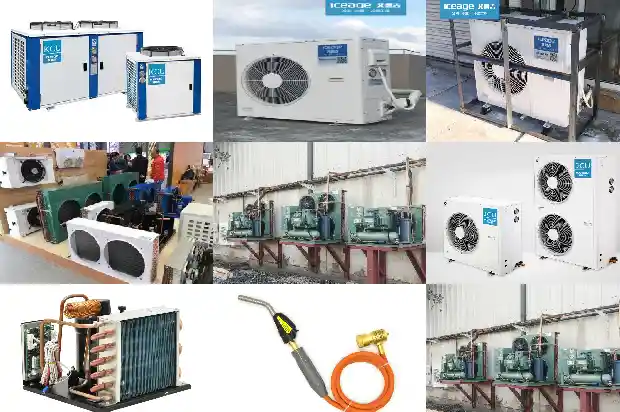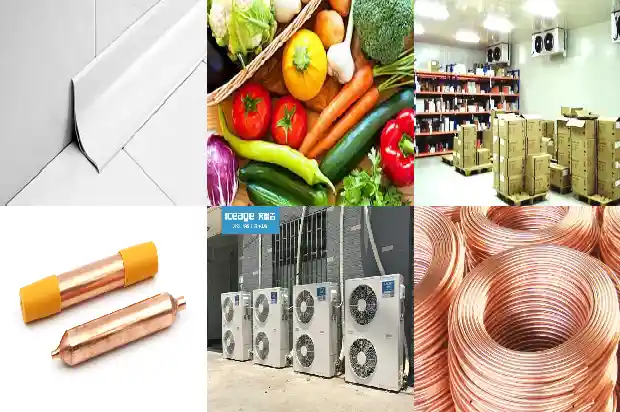Repairing Piston Type Compressors in Cooling Systems
2024-09-03
I. Compressor cannot start and run normally
- Power supply failure: power failure, low voltage, lack of phase
- Electrical circuit failure: fuse, loose connection of contactor wiring
- Motor failure;
- High pressure in crankcase;
- Energy at high load position;
- Refrigerant water temperature reaches the set value of temperature controller or temperature controller fails;
- Pressure relay: set value is too low, alarm is not reset, malfunction.
- Thermal relay has not been reset after operation;
- Low oil pressure, unable to establish normal oil pressure;
- Cooling water and refrigerant water of cooling and brine unit are cut off. Water flow relay alarms or water flow relay fails.
II. Sudden shutdown during normal operation of compressor
- Power failure.
- The operating parameters of the unit reach the alarm set value of the unit and shut down due to alarm. Common alarm messages mainly include:
① Main motor overload protection shutdown. Mainly due to high suction pressure and discharge pressure of the unit or improper assembly of moving parts of the unit, resulting in motor overload. Find out the cause of excessive pressure. The compressor should be relatively easy to turn by hand. If it is relatively heavy, it should be disassembled and inspected.
② Excessive discharge pressure, pressure relay alarms and shuts down.
③ Low oil pressure difference protection shutdown. Check the causes of low oil pressure.
④ Alarm shutdown due to cut-off of cooling water and refrigerant water of the unit. Check whether the cooling water and refrigerant water systems are normal.
⑤ Ultra-low temperature alarm shutdown of refrigerant water of the unit. Check whether the refrigerant water temperature reaches the set value and appropriately reduce the load position of the compressor.
III. Low oil pressure
- Oil pump pipeline is blocked or leaking oil. Clean and dredge the oil pipeline.
- Improper adjustment or malfunction of oil pressure regulating valve. Adjust the oil pressure and disassemble and inspect the oil pressure regulating valve.
- Lack of oil, supplement an appropriate amount of lubricating oil.
- Liquid enters the crankcase. The oil pump sucks oil with foam, causing the oil pressure to drop. Shut down, remove the ammonia liquid in the crankcase or replace with new lubricating oil.
- Oil pump is worn. Disassemble and inspect the oil pump.
- Connecting rod bearing bush and main bearing, small end bushing and piston pin are severely worn. Inspect, repair or replace severely worn parts.
- The gauge valve of the oil pressure gauge is not opened or the gauge is malfunctioning. Check the gauge valve and calibrate the pressure gauge.
- Oil filter is clogged. Disassemble and wash the oil filter screen. Note to clean the crankcase at the same time.
- High oil temperature and decreased viscosity of lubricating oil cause low oil pressure.
IV. Foaming in crankcase
- A large amount of liquid enters the crankcase. When the pressure is reduced, foam is caused by evaporation of ammonia liquid. Empty the ammonia liquid in the crankcase.
- Excessive oil is added to the crankcase. The connecting rod big end stirs the lubricating oil and causes foam. Drain excessive lubricating oil.
V. Excessive oil temperature
- No water supply or high water temperature and insufficient water volume for the oil cooler in the crankcase. Check the cooling water system.
- The assembly clearance between bearing bush and bearing is too small. Impurities in lubricating oil cause scoring of bearing bush, etc. Abnormal wear generates a large amount of frictional heat.
Adjust the assembly clearance to meet the requirements. Replace with new oil and worn parts such as bearing bush.
- Excessive discharge temperature. Check the causes of excessive discharge temperature.
VI. Oil consumption of compressor
- Piston ring, oil ring and cylinder liner are worn. Check the locking gap of piston ring and oil ring. Replace those with excessive gap.
- The oil ring is installed reversely or the locking gap is installed in a line. Reassemble the oil ring and arrange the three locking gaps evenly.
- Excessive discharge temperature causes the lubricating oil to vaporize and be carried away.
- Excessive oil is added. Drain the excess lubricating oil.
- The automatic oil return valve of oil separator is malfunctioning. The oil return valve from the suction chamber of high-pressure stage to the suction chamber of low-pressure stage is not closed.
- The compressor returns liquid. The vaporization of refrigerant carries away a large amount of lubricating oil.
Pay attention to adjusting the liquid supply during operation to prevent liquid return.
- Excessive oil leakage from shaft seal.
- The sealing ring of high-pressure cylinder liner of single-unit two-stage unit fails. Replace the sealing ring.
- Excessive oil pressure. Adjust the oil pressure according to the suction pressure.
- Oil leakage at the oil cylinder of energy regulation unloading device.
- The lubricating oil in the suction chamber cannot smoothly return to the crankcase directly through the oil return balance hole.
VII. Knocking sound in crankcase
- The clearance between the main bearing bush of connecting rod big end and crankshaft journal is too large. Adjust and replace with a new bearing bush or new crankshaft.
- The clearance between main bearing and main journal is too large. Repair and adjust.
- The cotter pin is broken and the connecting rod bolt is loose. Tighten the bolt and replace the cotter pin;
- The center of coupling is not correct or the coupling keyway is loose. Adjust the coupling and repair the keyway;
- Poor lubrication of main bearing. Find out the cause of low oil pressure.
Related Articles
- Common Faults and Troubleshooting Methods of the Moving Mechanism of Piston Compressors
- Principle and Refrigeration Process of Piston Refrigeration Compressor
- Operation of Screw - type Water - cooled Chiller Units
- Basic Knowledge of Valve - type Components in Refrigeration Systems (Technical Sharing)
- Introduction to Basic Types of Cold Storage
- Cleaning Methods for Different Types of Condensers in Refrigeration Devices
- How to Choose between Open - type and Closed - type Cooling Towers?
- Reference Points for Selection of Screw - type Chillers
- Elastocaloric refrigeration: A new type of solid-state refrigeration technology
- Types and Temperature Requirements of Seed Cold Storages
- Maintenance and Repair of Screw Type Cold Water Heaters
- Introduction to Types of Condensers in Cold Storage
- What are the important significances of a warm environment for various types of food?
- Maintenance of General-purpose Screw-type Water-cooled Chillers
- Screw-Type Water Cooled Unit Normal Operation Indicators and Failure Handling
- 5 Common Types of Refrigeration Compressors
- Four types of flammable and explosive refrigerants
- The characteristics and uses of 26 types of air conditioning refrigerants
